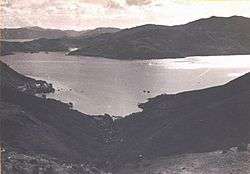Tseung Kwan O
| Tseung Kwan O | |
|---|---|
| Town | |
 | |
| Country | China |
| Region | New Territories |
| District | Sai Kung |
| Population (2011) | |
| • Total | 368,000 |
| Tseung Kwan O | |||||||||||||
| Traditional Chinese | 將軍澳 | ||||||||||||
|---|---|---|---|---|---|---|---|---|---|---|---|---|---|
| Simplified Chinese | 将军澳 | ||||||||||||
| |||||||||||||

Tseung Kwan O (also called Cheung Kwan O or Junk Bay) is a bay in Sai Kung District, New Territories, Hong Kong. In the northern tip of the bay lies the Tseung Kwan O Village.
The Tseung Kwan O New Town, one of the nine new towns in Hong Kong, was mainly built on reclaimed land in the northern half of the bay. The current population as of 2011 is about 368,000.[1]
Name
In Cantonese, Tseung Kwan (將軍) means the "general" of an army, and O (澳) means "bay". Therefore, Tseung Kwan O literally means "general's Bay".
The exact origin of the name Tseung Kwan O is unknown, but it is said to be named in honour of a Ming Dynasty soldier who visited Tseung Kwan O at some point. Another theory is that the name was chosen in the 17th century, when naval battles were fought against pirates from Japan at Tseung Kwan O. Yet another theory is that the pronunciation of "將軍" can sound like "Junk Wan" to the ears of English speakers; wan is also a transliteration of the Chinese word for "bay" (灣).
The current town center of Tseung Kwan O stands on reclaimed land. The English name Junk Bay was said to be derived from the existence of junks in the bay, and the reclamation land based on the landfill . The first landfill was opened in 1978, decades after Junk Bay was named.[2] The Fat Tong Chau (Junk Island) is in the southeastern part of the bay.
History and geography

The bay is near the eastern mouth of Hong Kong's Victoria Harbour.
Before the development of the new town, the area around the bay was occupied by a number of fishing towns and villages. Settlements in the area began as early as in the 13th Century, 800 years ago. Major settlements, however, did not occur until the late 16th Century when small fishing villages were founded in the area. Hang Hau quickly emerged into a market town and became the most populated and prosperous place in the whole of Clear Water Bay Peninsula, and continued for the next few centuries as such.[3] Other towns and villages include Rennie's Mill (Tiu Keng Leng), Hang Hau and Yau Yu Wan. Rennie's Mill was where Kuomintang loyalists were settled following the end of the Chinese civil war, and Hang Hau had a ship building industry.
The Hong Kong Government had been interested in developing a new town at Hang Hau because of its proximity to the urban area. The project was postponed for a long time owing to the extensive scale of reclamation in the bay, which is rather deep. It finally started under the name of Tseung Kwan O. The area of Tseung Kwan O is about 1,790 ha, with a projected population of 490,000 upon completion.[4]
Development of Tseung Kwan O
In 1983, development of Phase I of the New Town to an initial population of about 175,000 was formally endorsed. By 1986, construction of the two tubes of Tseung Kwan O Tunnel began, which provided potential for further increasing the population of the New Town. To maximize the utilization of the road infrastructure and to meet the demand for land for public housing, the Government decided that the New Town should include a Phase II development, with an increase in the projected population to about 325,000. To cater for redevelopment of the Tiu Keng Leng Cottage Area and to provide land for development of Tseung Kwan O Industrial Estate and deep waterfront industries, in 1988, the Government further decided to proceed with Phase III development of the New Town for about 490,000 people.[5][6]
Photo gallery
- Tseung Kwan O Library at Dusk
 High density buildings in Hang Hau
High density buildings in Hang Hau Tseung Kwan O Town Centre
Tseung Kwan O Town Centre Tseung Kwan O Village
Tseung Kwan O Village Po Lam Estate
Po Lam Estate Tseung Kwan O South
Tseung Kwan O South
See also
References
| Wikimedia Commons has media related to Tseung Kwan O. |
- ↑ http://www.cedd.gov.hk/eng/about/achievements/regional/regi_tko.htm
- ↑ Waste management in Hong Kong
- ↑ http://www.pland.gov.hk/pland_en/press/publication/nt_pamphlet02/tko_html/hist.html
- ↑ http://www.pland.gov.hk/pland_en/press/publication/nt_pamphlet02/tko_html/geo.html
- ↑ http://www.pland.gov.hk/pland_en/press/publication/nt_pamphlet02/tko_html/index.html
- ↑ http://www.pland.gov.hk/pland_en/press/publication/nt_pamphlet02/tko_html/develop.html
Coordinates: 22°18′N 114°15′E / 22.300°N 114.250°E